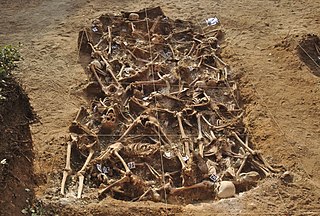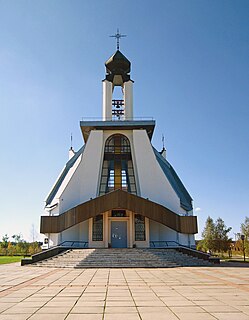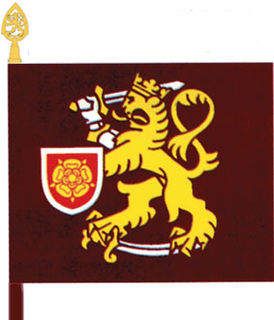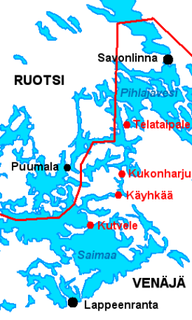
Joutseno is a former town and municipality of Finland. It is located in the province of Southern Finland and is part of the South Karelia region. Joutseno had a population of 10,821 (2004) and covers an area of 498,8 km² of which 187,7 km² is water. The region shares nine kilometers of borderline with Russia. The population density is 34,8 inhabitants per km². Joutseno is unilingually Finnish. Until 2005, Joutseno's status was changed to city. Joutseno was consolidated with Lappeenranta on 2009-01-01. A referendum was held, by public demand, before the amalgamation and the result was 73.9% against joining Lappeenranta. The referendum result was not considered binding, however, and the merger was carried out regardless.

A mass grave is a grave containing multiple human corpses, which may or may not be identified prior to burial. The United Nations has defined a criminal mass grave as a burial site containing three or more victims of execution, although an exact definition is not unanimously agreed upon. Mass graves are usually created after many people die or are killed, and there is a desire to bury the corpses quickly for sanitation concerns. Although mass graves can be used during major conflicts such as war and crime, in modern times they may be used after a famine, epidemic, or natural disaster. In disasters, mass graves are used for infection and disease control. In such cases, there is often a breakdown of the social infrastructure that would enable proper identification and disposal of individual bodies.

Fromelles is a commune in the Nord department in northern France. In 2004 it had a population of 907; its inhabitants are called Fromellois. It is located about 16 kilometres (9.9 mi) to the west of Lille.
Battlefield archaeology is a sub-discipline of archaeology which studies the material remains and topography of a battlefield to understand a conflict. Archaeological battlefields consist of skirmishes, sieges, camps, and training sites. The study of the relationships and contexts of the material by-products of war give an alternate account to the version recorded in a history book, poem, or witness account, which may be constructed though bias, or may present only a limited perspective of the events. Examination of these locations gives insight to what tactics were being used, weapon modifications, and battle formations. It is not considered distinct from Military archaeology or Recceology.

Dem'ianiv Laz is a mass burial site of victims of the Soviet extrajudicial killings committed following the Soviet invasion of Poland near Stanisławów. At least 524 captives were shot by the NKVD and buried in several mass graves dug by the prisoners themselves in a small gorge outside of the city.

In Chechnya, mass graves containing hundreds of corpses have been uncovered since the beginning of the Chechen wars in 1994. As of June 2008, there were 57 registered locations of mass graves in Chechnya. According to Amnesty International, thousands may be buried in unmarked graves including up to 5,000 civilians who disappeared since the beginning of the Second Chechen War in 1999. In 2008, the largest mass grave found to date was uncovered in Grozny, containing some 800 bodies from the First Chechen War in 1995. Russia's general policy to the Chechen mass graves is to not exhume them.
Huhtiniemi mass grave is a mass grave site with two graves and at least 15 bodies in Huhtiniemi, Lappeenranta, eastern Finland. Further 10 bodies were excavated already in 1971, leading for the more recent studies, and fragments of two other individuals were found in 2005 in rough examinations by City of Lappeenranta.
In 1998, allegations of mass graves at Chemmani were made by a Sri Lankan soldier on trial for rape and murder. He claimed hundreds of people who disappeared from the Jaffna peninsula after it was retaken by Government troops from the LTTE in 1995 and 1996 were killed and buried in mass graves near the village of Chemmani. There are reports about 300 to 400 bodies being buried there.

Mass graves in Iraq have become well known since the 2003 invasion of Iraq toppled the regime of Saddam Hussein. International Experts estimated that 300,000 victims could be in these mass graves alone. The mass graves mostly included the remains of Shia Muslims and ethnic Kurds, who were killed for opposing the regime between 1983 and 1991.

The Duraiappa stadium mass grave was discovered and excavated at the Duraiappah Sports Stadium in the formerly embattled northern city of Jaffna, Sri Lanka, during a period of relative calm between civil conflicts. The mass grave was unearthed in stages between April 4 and 10 of 1999.

The Finnish National Defence University is the Finnish Defence Forces' university located in Helsinki. The university trains officers for the Defence Forces and the Finnish Border Guard. The main campus is located in Santahamina, Helsinki.

The Vinnytsia massacre was a mass execution of between 9,000 and 11,000 people in the Ukrainian town of Vinnytsia by the Soviet secret police NKVD during the Great Purge or Yezhovshchina in 1937–1938. Mass graves in Vinnytsia were discovered during Nazi Germany's occupation of Ukraine in 1943. The investigation of the site first conducted by the international Katyn Commission coincided with the discovery of a similar mass murder site of Polish prisoners of war in Katyn. Nazi Germany utilized this evidence of Communist terror to discredit the Soviet Union internationally. It became one of the better known sites of politically motivated NKVD massacres among many in Ukraine.

The region of Semna is 15 miles south of Wadi Halfa and is situated where rocks cross the Nile narrowing its flow—the Semna Cataract.

Tlatelolco is an archaeological excavation site in Mexico City, Mexico where remains of the pre-Columbian city-state of the same name have been found. It is centered on the Plaza de las Tres Culturas. On one side of the square is this excavated Tlatelolco site, on a second is the oldest European school of higher learning in the Americas called the Colegio de Santa Cruz de Tlatelolco, and on the third stands a mid-20th-century modern office complex, formerly housing the Mexican Foreign Ministry, and since 2005 used as the Centro Cultural Universitario of UNAM.

Suvorov military canals is a series of four open canals on Saimaa lake in Finland. The four canals of Kutvele, Käyhkää, Kukonharju and Telataipale are located in Puumala, Ruokolahti and Sulkava. They were built between 1791 and 1798 as part of the South-Eastern Finland fortification system and are the oldest canals in Finland. The canals are named after general Alexander Suvorov who ordered their construction.

Brookwood American Cemetery and Memorial is the only American Military Cemetery of World War I in the British Isles. Located approximately 28 miles (45 km) southwest of London, Brookwood American Cemetery contains the graves of 468 American war dead, including the graves of 41 unknown servicemen, from World War I.
The Tatarka common graves were mass graves discovered in April–August 1943, during World War II, by Axis-allied Romanian troops occupying Transnistria, on a lot of 1,000 m2 (11,000 sq ft) in Tatarka, now Prylymanske, in Odessa Raion, near Odessa. Some 42 separate common graves of several dozen bodies each were identified, containing between 3,500 and 5,000 bodies, of which 516 were exhumed, studied, and buried in a cemetery before the region became a front line. The commission set up by the Romanian authorities to investigate these graves reported that among the dead were persons arrested in the Moldavian ASSR in 1938–1940 and in Bessarabia and northern Bukovina in 1940–1941.

Jedars are thirteen Berber mausoleums located south of Tiaret city in Algeria. The name is derived from the Arabic: جدار jidār (wall), which is used locally to refer to ancient monumental ruins. These pre-Islamic tombs date from Late Antiquity.
Mass graves in Celje were created in Celje, Slovenia, after the Second World War, from 1945 to 1956. The 11 known mass graves in Celje itself and 14 in the immediate vicinity include some of the largest mass graves in Slovenia.













